Saïs Report, 2010
Season Reports
Saïs Report, 2010Post-Excavation Work
Two main sets of material were studied in preparation for publication of previous excavations at Sa el-Hagar.
Post-excavation study of material from the Prehistoric Excavation 8.
As noted above, Dr Karl Lorenz visited Sais with a view to collecting as much information as possible about the Buto-Maadi Period material excavated in 2005. he brought with him photographs from Tell el Farkha and Tell el Iswid of sherds identified as ‘Farsenware’ or ‘Hairy Pottery’. The identification was first made at Buto by Christiana Köhler and she argued that it was a particular cultural feature of Lower Egypt prior to the Unification. The pottery seems to have a been a ‘fibrous’ tempered fabric, although the nature the ‘fibrous’ material was not known. When Dr Gregory Gilbert first did our Prehistoric pottery analysis, he kept to one side a group of slipped and polished sherds, which had a strange ‘fibrous’ appearance on the outer surface. It seems that these sherds were in fact the ‘hairy’ or ‘fibrous’ sherds which had also been identified at the other Delta sites mentioned above. It was necessary, therefore, to check the Prehistoric material, in particular the sherds characterised by tiny fibres or their impressions visible on the surface of the pottery. Sometimes the fibres can be seen in the break of the wares as well, but the material at Sais seems to suggest that the fibrous material is a surface treatment. The fibres can be seen as impressions in the slip applied to the surface of the vessels which was then either smoothed or polished.
Indeed, this meant that all of the Buto-Maadi period sherds had to be rechecked and counted. I am very grateful to Sam Wilford, because without him I would never have had the patience to keep going. We also created a good photographic database of the fabrics from the Prehistoric period, as well as the Greek import series from the Waste-water project (see below).
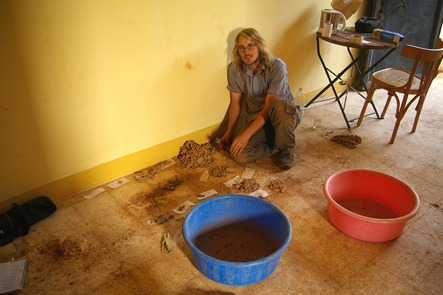
Sam Wilford valiantly counting Predynastic sherds.
All of the Buto-Maadi period pottery was checked and a new statistical analysis prepared on the basis of the results. A total of 18,089 sherds was counted from the Buto-Maadi period contexts [8008, 8009, 8012 and 8014], of which 71% were tempered ware 1, 5.6% were the fibrous treated pottery (mostly Ware 1, although a few Ware 2 examples were noted), 20% were the untempered Ware 2 and 3.4% were coarse or very fine wares.
The ‘fibrous’ types had distinctive red, black and brown polished slip, or no slip and smoothed surfaces. The sherds also tended to show smoothing with a brush or other tool on the inside of the vessel, which survived remarkably well. The fibres are extremely fine and do not seem to be hair, but may be the impressions of some organic material such as fine flax fibres, which have been mostly burnt out of the sherds.
The Lower Egyptian nature of this treatment may relate to the early uses of flax and also have been specifically designed to improve the quality of the paint/slip finish. The fibres may have enabled the slip to adhere better to the surface of the pottery. this is just a working hypothesis until we can get a sample of a surviving fibre and have it analysed microscopically.
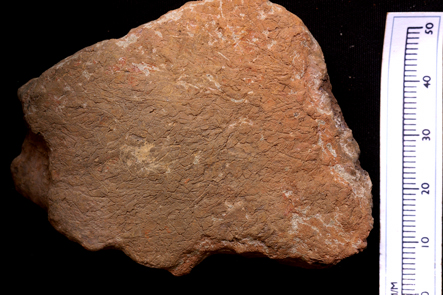
Outer surface of red slipped and polished (?) ‘fibrous’ tempered sherd.
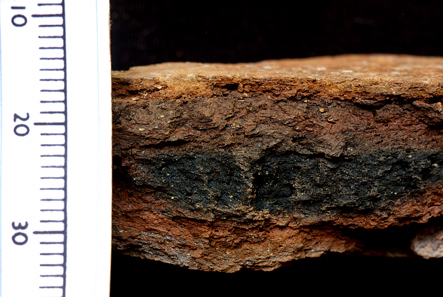
Section of the sherd. Can any fibrous strands be seen?
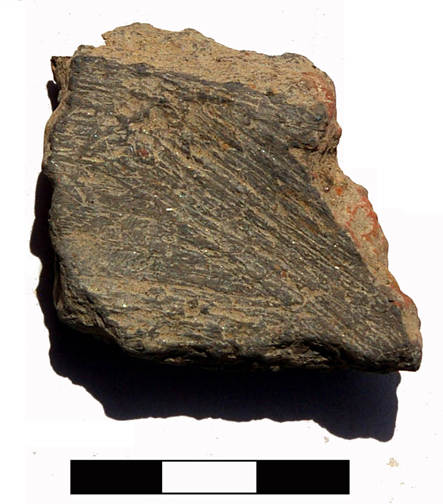
Back of a ‘fibrous’ tempered sherd, showing apparent brush strokes on the fabric.
Study of pottery collected from the Waste Water project of the village of Sa el-Hagar.
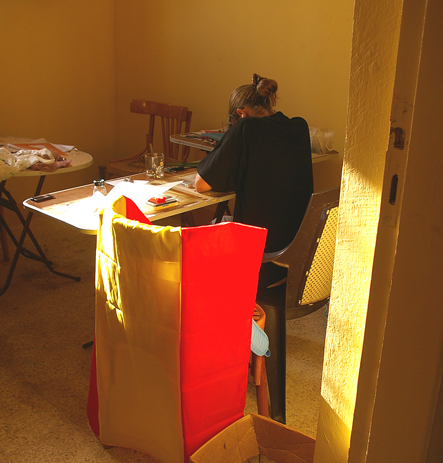
Marina Escolano at work on the day after Spain won the World Cup.
Following the development of our system for dealing with the large quantities of pottery collected from the village of Sa el Hagar, altogether 23 further units of pottery and stone were analysed, of which 1653 examples were recorded and, of those, approximately 350 examples were drawn. Here Durham University archaeologists were put to the test in the heat of a very hot summer, wading through basket after basket of sherds and cheerfully drawing, recording and preserving for posterity information from the depths of the Saite city.
I’m grateful to Jess Greenhalgh, Eleanor Henderson, Justin Scarfe, Sophie Mills and Hannah Mosley for their hard work in difficult conditions. Marina Escolano (now a Fulbright Scholar at Johns Hopkins University) created fine drawings of the complete vessels. She was particularly happy this year, because Spain won the World Cup and we were able to watch it live. Our guards were also happy because it meant that the drinks (Cola) were on me!
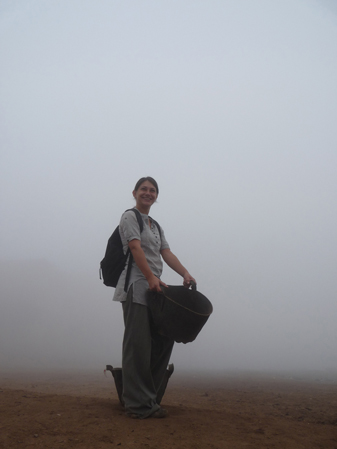
Aude Simony on the lookout for more pottery in the fog.
The material recorded provides important information about the archaeological layers underneath the village of Sa el Hagar, which would be otherwise difficult to collect.
Although a basic typology of the material had been created in 2009, Aude Simony (now a doctoral student at the University of Poitiers) improved and completed a systematic study of the vessels collected. This is her preliminary analysis of the material we studied.
Fabrics
Most of the vessels studied were made of Nile silt and the three most common types were:
Fabric I: Nile Silt, fine and hard, dense. Uniform red-brown to brown or orangey with red core.
Inclusions: Very fine sand, quite abundant, rare small rounded inclusions of white limestone (less than 0, 5 mm), fine mica very abundant (visible in surface and in break).
Types: Flagons, Uguentaria, Cooking-pots, small amphora, jugs
Fabric II: Nile Silt closed to Fabric 1, a little bit more granular. Fine and hard, dense.
Uniform red- brown to brown or brown with red core.
Inclusions : Very fine sand, few small white limestone inclusions (rounded and inferior to 0, 5 mm), few yellow limestone inclusions ( average 1mm), small chaffs, fine mica abundant visible in surface and in break.
Types : Bowls with incurved rim, cooking pots, bowls with low carination and ovoid jars
Fabric III: Nile Silt, medium fine and medium had. Granulous aspect.
Light brown with red core or light brown, red with black core.
Inclusions: Few grains of sand, quite abundant fine yellow and white limestone inclusions (rounded or in filaments, average 1mm), abundant small chaff, rare small rounded black bits, mica fine and abundant.
Types: Bowls with incurved rim, bowls with low carination, small bowls and ovoid jars
A further 13 varieties of tempered Nile silt and 1 marl fabric were identified, which was used for a small jug or flagon.
Shape Classification
Altogether 12 Open forms were identified. The most common were the bowls with incurved rim and other forms included bowls with low carination, thickened rim saucers, beakers with triangular rim, plates with flat rim, carinated bowls, cups. A further 9 closed shape forms were identified of which the most common type were the jugs and ovoid jars, and also included unguentaria, flagons or juglets, miniature amphorae.
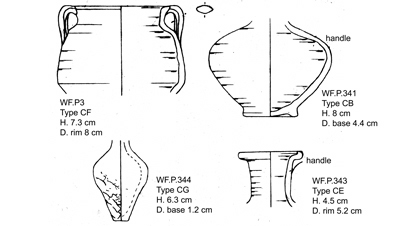
Assorted pottery shapes (drawings by Aude Simony).
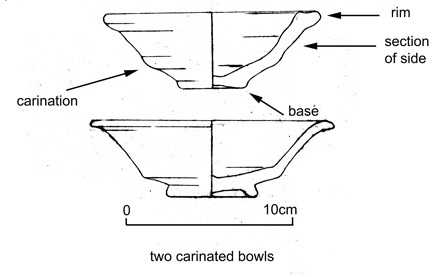
Two bowl types. Although both can be described as carinated bowls, they have different rims (one is everted, one grooved), the section of the body is concave in one case and more undulating and thicker walled in the other and the bases are different. We assign the pottery to one or other of the groups to determine whether the difference in shape is significant or just a one off. Following from this we would attempt to show whether the differences are because the bowls had different uses, represent a different workshop or represent aesthetic choices available to customers.
This first examination of the material suggested that the assemblage contained a mixture of different elements from different periods. The analysis of the pottery suggests a date of the whole group between the Saite Period and Early Roman Times.
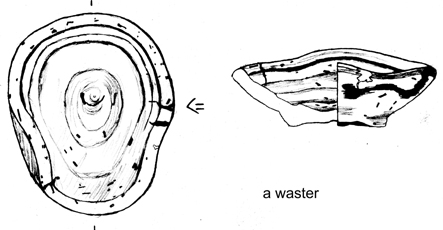
A waster, made beautiful in this drawing by Marina Escolano.
The presence of wasters, that is burnt material or pottery presenting some deformation can be considered as a clue to a local production of pottery, which took place on the site during Ptolemaic times until the beginning of Roman Period. Further study is needed in order to discover whether the material came from workshops at Sais, or whether it had been made elsewhere and was brought to Sais for sale or distribution.
Post excavation study of other material.
Small finds from Excavations 5 and 6 were drawn by Marina Escolano for the eventual publication of those areas.
Mikaël Pesenti studied the imported amphorae from Excavation 4, in order to compare the material to that from other north Egyptian sites including Tanis, in preparation for the publication of the excavation and for his PhD. Samples of archaic Greek amphorae were taken to the French Institute in Cairo, where they can be analysed in order to assist with identification of their origin. The most problematic material are the Samian amphorae – apparently a lot of amphorae are said to come from the island of Samos, but it is not certain if that is the case.
Excavation 11 on the Western side of the Great Pit.
Appendix 1 : Contexts for Excavation 11
The excavation was carried out under very difficult conditions. Our workforce and SCA Inspector, Mrs Rania Sobhy were fantastic. It was Ramadan and August, so we began work at 5.30 in order to finish at 10.30. This meant that I could go back to bed for two hours, have my lunch and then work on the pottery during the afternoon. It was a very good way to work. We also hired a wedding awning to provide some shade, because the trenches were directly under the sun all morning. There are no weddings during Ramadan, so the awning was not needed by anyone else.
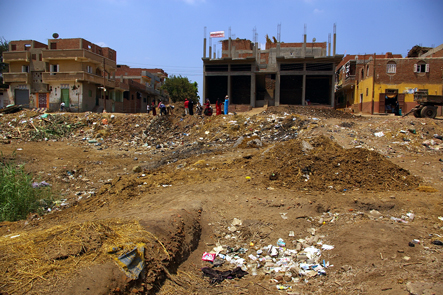
Location of Excavation 11, east of excavation 4 on the main track around the Great Pit.
Preliminary Drill Cores
Before the excavation 6 drill cores were carried out in the area chosen for the work, in order to give some information about the expected layers.
Core 11.1: On the edge of the Great Pit went to a depth of 10.13m from the ground surface. Modern rubbish to 2m depth; black burnt material with pottery in alternating layers to 3.48 m; layer of broken quartzite fragments between 3.48 and 3.66m; thick anthropogenic layer with pottery and burning inclusions up to 90% of the content by 5.22 m; by 6.13 this layer ended in cleaner sandy-clay and a new anthropogenic layer began between 6.22 and 7.24 m; there was then compact layers of Clay-silt with increasing sand from 7.50 m to 10.13m and the last core. It is likely that the upper layer of human cultural material represent the Saite period and later; with the lower layer of material representing the Prehistoric levels.
Core 11.2: to the south of the house beside which Excavation 11 was made in the waste land subsequently offered for sale. This core went to a depth of 2.66m below ground level, when it was stopped by a limestone block. Between this depth and the end of the core there were layers of human cultural material (pottery, bone and burning, at times up to 30% of the core sample, and containing red polished Late Period pottery fragments.
Core 11.3: made 2m to the east of the last core. It went to a depth of 3.5 m below the ground level and contained much human cultural material with two gaps in the sequence between 2.21 and 2.62m and from 3.39 to the end of the core at 3.5m.
Core 11.4: was made approximately 5 m north of the last auger, about 2m west of the house and subsequently where our trench 11.2 was made. The core reached a depth of 1.86 m below the ground before it hit a limestone blockage. The upper modern rubbish layers gave way to greyish silty-clay which may have been a wall, before a change at 1.57 m below the ground when there was a layer of dense human cultural material before the limestone blockage was reached.
Core 11.5: made 7m north of Core 11.4 , about 1.5 m from the wall of the house. The core went down to 3.66m below the ground level. There was modern rubbish at the top of the core and then between 1m and 2.30m there were layers of burnt material and pottery, then a cleaner silty-clay layer to 3m and then further pottery and burning layers to the last core.
Core 11.6: made in the street north of the building about 5m from the end of the street. This core hit a water pipe at 1.22 m and was abandoned.
Altogether, the cores suggested an area with rich archaeological deposits underneath a modern rubbish layer. It was difficult to differentiate between the different strata of burning and pottery as they seemed very similar from core to core. This perhaps indicated that we were not in an area with prime stratified deposits, but the joy of all archaeologists we had found a huge, old pile of rubbish!! Just what we were looking for.
Excavation 11
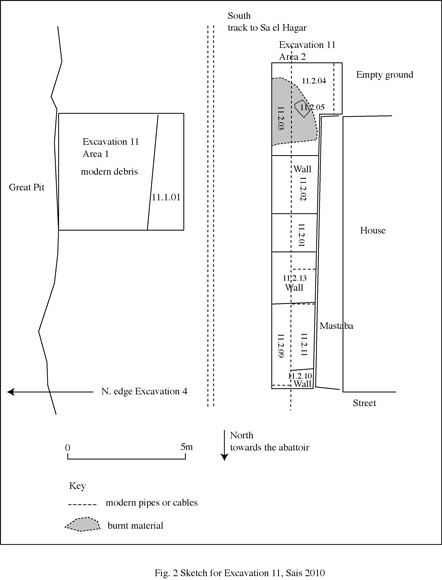
Sketch plan of Excavation 11.
The area chosen was directly adjacent to our Excavation 4 trench from 2003 where we had found a Saite pottery and rubbish dump and a well dating to the late Saite period, around 550-500 BC. The excavation area was much higher than Excavation 4, so that we could have some information about the chronology of the layers between the late Saite period and the modern day. The area chosen was complicated by the modern layers, in particular the presence of fresh water pipes, the waste water pipes and underground telephone cabling. For this reason it was not possible to excavate a continuous trench but we had to excavate on either side of the waste water pipes and the fresh water pipes ran through our second area of excavations.
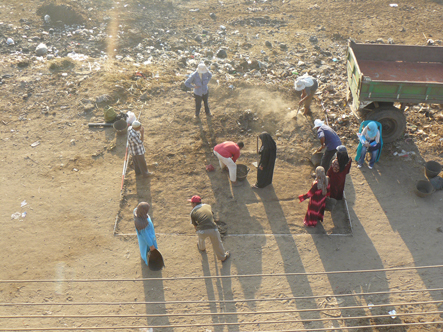
Excavation 11 from above.
Area 1: a trench 5 m by 5m was excavated on the edge of the Great Pit, in line with Excavation 4. As the trench was on part of the track around the Pit, upper layers comprised hard compacted material and the eastern side of the trench was almost completely modern rubbish. Some redeposited pottery was found amongst the rubbish but it was clearly from extremely disturbed layers. On the western side of the trench the remains of a mud brick wall were found at a depth of 48 cm from the ground level (Context 11.1.01). The wall was made of grey coloured bricks and seemed to be substantial running from east to west. The eastern side of the wall was eroded slightly and the western side continued underneath the main track. the width of the wall preserved in the trench was 1.10 m at the south end and 1.5 m at the northern end. In the original survey of the site, it been suggested that there had been an enclosure wall around the southern part of the site, that is the Great Pit. The fact that the track runs along the wall and that the modern housing is built just to the western side of it, seems to confirm that the likelihood that some kind of wall did indeed run underneath it. The layer on top of the large wall was a burnt layer of compressed debris, but included some ancient pottery mixed with modern material.

Excavation 11.1 Possible mud brick wall at the west side of trench. The ranging rod is 2 metres long.
Area 2: The trench for Excavation 11.2 was excavated directly opposite Excavation 11.1, leaving the area between the two areas clear because this was where the waste water pipes were located. Excavation 11.2 ran alongside a house built on the side of the Pit, extending for a distance of 14 m from north to south and ranging in width from 3m at the southern end to 1.80 m at the northern end. Although the upper 30-50 cm of the trench consisted of modern building debris and trash, the lower layers were ancient layers of redeposited material and perhaps some primary deposits of pottery in situ.
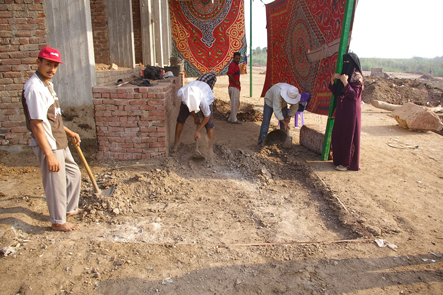
The start of the work with a ‘wedding’ awning for shade.
At the southern end, the trench was excavated to a depth of 24 cm where there was a layer of burnt material (Context 11.02.3), including fragments of pottery on the eastern side. This had been cut through by the fresh water pipe but was clearly visible in the trench. On the western side of the burnt area there was a pit (Context 11.2.04) which contained a large pottery bucket base, fragments of imported amphorae and a redeposited group (Context 11.2.05) consisting of a large, straight sided red pottery vessel with square section rim, inside it a mushroom rimmed amphora neck. The whole group had been thrown down on top of the base and body of a Samian type amphora. The area of burnt material (Context 11.2.03) extended for a distance of around 3m and contained much pottery and some burnt bone.
The next 3 m to the north consisted of a relatively solid wall of grey mud brick (Context 11.2.02), although no individual bricks were visible. The wall actually continued to the west underneath the house beside the trench. The next 2.5 m to the north (Context 11.2.01) was an area of loose brown fill which contained a medium density of pottery including both Egyptian material and imported amphorae. The first impression is that the material was a mixture of Late period, Saite and possibly Ptolemaic material.
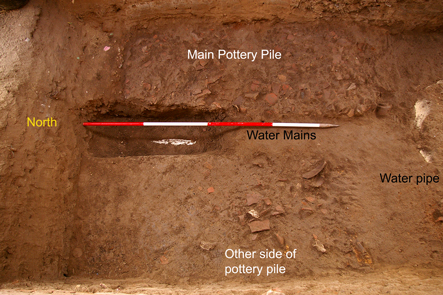
Pottery pile cut through by water pipe. There’s still more than enough pottery to study.
There was then another section of grey mud brick wall for a distance of 3.40 m and the northern part of the trench comprised a massive pottery pit, measuring approximately 3m by 1.80 m in extent and the depth of 50 cm was excavated, but it is possible that this was not the total depth of the deposit. It may also have been cut off at the top in order to create the surface of the track. The pottery deposit was excavated in layers according to the position of the complete vessels within the deposit, so each layer was around 10 cm thick.The pottery was extremely dense and was excavated on both sides of the water pipe cutting through it. The pottery was much thicker on the eastern side (Context 11.2.09) where the soil-matrix with it was greyish in colour with patches of charcoal, but no extensive signs of burning. There was also a few bits of degraded faience and some bone included in the pottery deposit. The pottery on the western side of the water pipe (Context 11.2.11) was much less dense and the fill in which it was contained was looser and a more yellow silty-clay. At the northern end of the trench there was a ‘clean’ area (Context 11.2.10), perhaps a retaining wall against which the pottery had been deposited or placed.
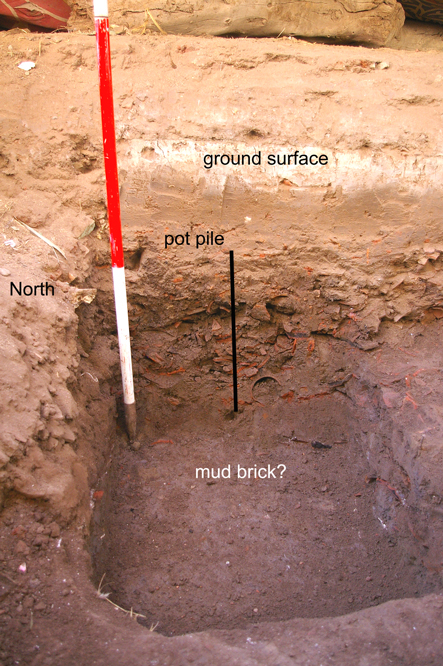
Section showing the depth of the pottery pile. The ranging rod segments are 50 cm long each, but the angle of the photograph is distorted.
The pottery was collected, counted and the diagnostic sherds were retained for recording. In addition fragments of 42 vessels were collected, which will be partly reconstructed in the next season. One complete vessel was found (A40). It was a juglet with one handle and a pink-light orange slip on the upper part of the outside. Its height was 13.5 cm, base diameter 4.5 cm, rim diameter 5.5 cm and maximum body diameter 8 cm. The juglet was of low quality but was registered and taken to the Tanta Antiquities Office.
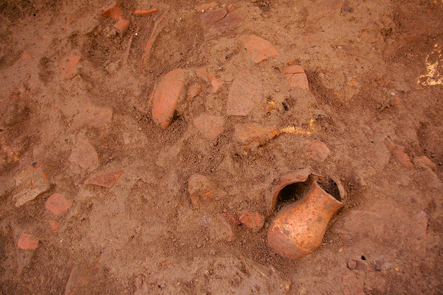
Complete jug from Excavation 11 in situ.
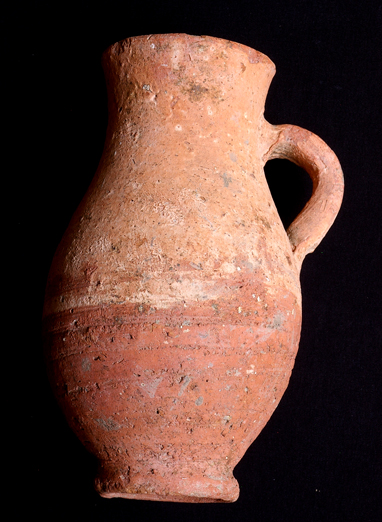
Complete jug cleaned and ready for a museum.
The most noticeable aspect of the pottery was that it comprised a large quantity of Nile silt ‘finewares’ or domestic tablewares, that is, material which was relatively small in size and including types such as bowls (with incurved rims, straight sides and grooved rims), ovoid jars, flat based small jars, open flared cups and plates with overturned rims. Altogether around 60% of the collected sherds were from such ‘fineware’ vessels.The other main groups of pottery came from amphorae, in particular the Amphore Égyptienne 3, made of a brown fabric, with long straight handles with right angled bend, and open slightly flared flat rim. The fragments from the amphorae comprised around 17% of the assemblage. This seems to be the early type of this vessel dating to the Imperial Roman period.It should be borne in mind that the finewares broke into many more smaller pieces than the amphorae, although judging from the amphorae bases and handles found we may be dealing with as few as four amphorae within the pottery deposit. A number of fragments of both other types of Egyptian amphorae and imported amphorae with orange coloured fabrics were also found.Amongst the medium Nile silts and coarsewares there were fragments of the Egyptian amphorae, as well as large buckets (especially the square and rectangular rimmed types), bread plates and perhaps some oven linings. There were a few marl vessels, including delicate fineware globular jars, some white painted Nile silt vessels, perhaps in imitation of the marls and a small number of the black fabric bowls. A production centre for these bowls and plates has been discovered at Buto and dated to the Ptolemaic period.Quantities of stone were also found amongst the pottery, mostly limestone fragments, some of which had worked edges and some of which were burnt. They all appeared to have been mixed with the pottery indiscriminately. One cuboid block of a hard stone such as basalt was also found, perhaps a weight mixed in with the material. All of the few faience fragments found were in very bad condition and without discernible shape or form.
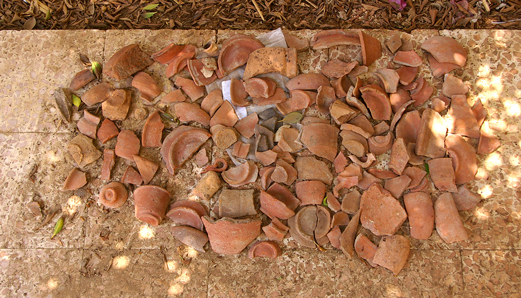
Pile of sorted and washed diagnostic pottery awaiting recording and study.
The date of the pottery material seems to be concentrated around the late Ptolemaic and Early Roman period, so perhaps between the 1st century BC to 1st century AD. The context for the deposit is not clear, however, and further excavation is required in order to find the underlying layers of the deposit.
Samples of Pottery sent to the French Institute under the supervision of the SCA Research Laboratory (Dr Khalid Omar).
Appendix 3 : List of pottery samples
Altogether 52 pottery samples were taken from pottery for Excavation 4 in order to be analysed for projects into the differentiation of Samian-type amphorae as well as Clazomenian amphorae to understand how the western and eastern types relate. In addition, 17 samples of the Late Ptolemaic-Early Roman Nile silt wares were also taken in order to understand the difference in firing and temper between the different types of material.
Summary
Despite being in the field for a relatively short time, a total of about 7 weeks, the Sais team completed a large body of work in very hot conditions in the summer.
The mission completed several areas of post excavation recording and study:
• analysis of the Buto-Maadi period pottery from Excavation 8;
• analysis of Excavation 4 pottery;
• drawing of material from Excavations 5, 6, 7 and 9;
• typological study, recording and drawing of pottery from the Waste Water Project at Sa el Hagar;
• samples of pottery were sent to the French Institute to enable future analysis and study.
• Excavation 11 was undertaken.
• Survey work was carried out in 4 satellite towns around Sa el Hagar.
The mission accomplished useful preliminary work in its area survey of the Saite area, discovering at least two late Roman settlements in its environs and traces of ancient waterways. Continued work on previously excavated material will expedite its publication.
Excavation 11 was very valuable in demonstrating the complexity of the urban deposits of Late period and Ptolemaic Sais. The pottery collected in this excavation will be very useful in comparison with other sites in the area, both from the viewpoint of the local Egyptian fine and coarseware pottery, Egyptian amphorae, as well as imported material from the Levant, Syria, Anatolia and the Aegean, as well as other material perhaps from Tripolitania and Italy. The discovery of a possible wall on the western side of the Pit is also a useful addition to knowledge about the form of the Saite southern city and the way in which it developed over time. The wall seems to have been built directly upon the sandy-silts of the clearance of the Great Pit area. In the later Saite period and perhaps Persian periods the wall in area to the west was reused as the foundation for various industrial areas. Cells were dug out of the wall to provide ready made units for shops or workshops, or the structure of the wall was originally in cell form, so that they filled up with rubble and debris easily in later times as the city expanded and created more refuse. The pottery deposit (11.2,09) may be one of these deposits of refuse, perhaps during the Roman period as the redevelopment of Sais continued in the western area of the southern enclosure.

The bougainvillaea in the magazine garden are doing very well along with various reeds, weeds and assorted seeds.
